|
|
|
Sort Order |
|
|
|
Items / Page
|
|
|
|
|
|
|
| Srl | Item |
| 1 |
ID:
184155
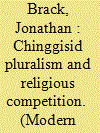

|
|
|
|
|
| Summary/Abstract |
This article argues that the Mongol empire's famous religious tolerance cannot be explained solely through its adoption of Inner Asian imperial political traditions of ruling over ethnically and religiously diverse subjects. Instead, this pluralism can be ascribed to a wider religious pattern of the Mongols. The first part argues that the analytical category of immanentist religions explains not only the inter-cultic transparency exhibited by the Mongol courts, but also the few explicit instances where the Chinggisid rulers reacted with ‘religious’ violence. The article further explores the strategies employed by the religious vectors, mainly Buddhists and Muslims, to address, accommodate, and subvert the Chinggisids’ patterns of religiosity and primarily their pluralism, and the Mongols’ deified mode of sacralizing kingship. Focusing on the Mongol-Ilkhanid court in Iran, the article examines how religious representatives used conceptual affinities and equivalences between the Mongol traditions and certain principles of their own religious frameworks to gain influence and favour, and persuade the khans to convert or retain their earlier commitment to the new religious affiliation. Employing this assimilative approach, they manoeuvred within the religious, immanentist paradigm of their nomadic patrons while moulding and manipulating it to their own religious, transcendentalist ends. The article further demonstrates how this ‘translation’ process of Chinggisid patterns became an arena of Buddhist–Muslim rivalry and competition, but also cross-cultural fertilization.
|
|
|
|
|
|
|
|
|
|
|
|
|
|
|
|
| 2 |
ID:
184160
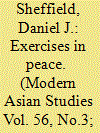

|
|
|
|
|
| Summary/Abstract |
In 1650, an encyclopedia of comparative religion known as Dabistān-i Maẕāhib (the School of Doctrines) was completed near the city of Hyderabad. Asserting that the religions of the world are reflections of a single inner truth, its author Mīrzā Ẕu'l-fiqār Āẕarsāsānī, known by the poetic penname ‘Mūbad’, travelled widely across India to record encounters with diverse religious figures. This article re-examines the composition and legacy of the Dabistān in light of new manuscript evidence relating to its author and the world he inhabited. It argues that the Dabistān's universalist project reflects a widely held theory of the interrelatedness of the macrocosm, in which sociality with diverse populations was understood to be a spiritual exercise leading to saintly perfection in the same way that venerating the cosmos and ascetic bodily practices were. The article provides a close reading of the Dabistān's shortest chapter on the religion of the Tibetans, the earliest such description in Persian. Situating the Dabistān within the diverse expressions of ‘Universal Peace’ (ṣulḥ-i kull) during the Safavid and Mughal periods, it argues that the Dabistān's project of recovering a universal theology that was attributed to ancient Iran and India led to expressions of dual religious belonging—to particular religions of revelation as well as to the universal religion of the philosophers—parallel to and connected with what Jan Assmann has termed the ‘religio duplex phenomenon’ in early modern Europe. Finally, the article briefly traces the legacy of the Dabistān into the modern period.
|
|
|
|
|
|
|
|
|
|
|
|
|
|
|
|
| 3 |
ID:
184156


|
|
|
|
|
| Summary/Abstract |
This article presents a new interpretation of the reign of the Ottoman sultan Mehmed the Conqueror (r. 1444–46, 1451–81) as refracted through the twin historical lenses of Mughal South Asia and the Renaissance Mediterranean. On the one hand, it argues that Mehmed, despite his current reputation as a conquering hero of Islam, in fact aspired to a model of sovereignty analogous to Akbar's Sulh-i Kull, and with a common point of origin in the conceptual worlds of post-Mongol Iran and Timurid central Asia. On the other hand, it also draws from the historiography of the Italian Renaissance to interpret Mehmed's cultural politics as being simultaneously inspired by a particular thread of Renaissance philosophy, the Prisca Theologia, which in many ways served as the Ottoman equivalent of Akbar's Sulh-i Kull.
|
|
|
|
|
|
|
|
|
|
|
|
|
|
|
|
| 4 |
ID:
184150
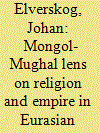

|
|
|
|
|
| Summary/Abstract |
This article introduces this special volume on the Mughal policy of sulh-i kull by situating the collection of articles in relation to broader developments across Eurasia.
The Catholic inquisitors of Europe who defended nonsense by cruelty,
might have been confounded by the example of a barbarian,
who anticipated the lessons of philosophy and established by his laws
a system of pure theism and perfect toleration…a singular conformity
may be found between the religious laws of Zingis Khan and Mr. Locke.
—Edward Gibbon, The History of the Decline and Fall of the Roman Empire1
In a word, the question is no longer whether Jesus was first
crucified and then resurrected, but how it came to pass that so many humans
today believe in the Crucifixion and Resurrection.
|
|
|
|
|
|
|
|
|
|
|
|
|
|
|
|
| 5 |
ID:
184157
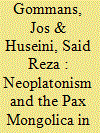

|
|
|
|
|
| Summary/Abstract |
This article argues that ṣulḥ-i kull (peace for all) as a specific term was introduced in the 1590s by a small group of avant-garde Neoplatonists who worked at the court of the Mughal emperor Akbar. It was only in the following century that ṣulḥ-i kull developed into the ethos that became the ideological mainstay of Mughal rule both internally, for its administrative elites, and externally, vis-à-vis their main rivals: the Uzbeks in Central Asia and the Safavids in Iran. The early stages in the making of this ideology can be followed in some detail by studying Akbar's neglected millennial history, the Tarikh-i Alfi. In fact, this vast Mughal world history demonstrates that apart from Neoplatonic akhlāq, there was another important building block that so far has been missing altogether in the making of ṣulḥ-i kull, that is, the practical model of the Pax Mongolica, as established under Chinggis Khan, the most famous of Mughal ancestors. Most crucially, it is in the Tarikh-i Alfi that we find the legacies of Persianate akhlāq and Mongol yasa (law) married to each other. In fact, it was through akhlāq that the peace of the Mongols became the Mughal peace for all.
|
|
|
|
|
|
|
|
|
|
|
|
|
|
|
|
| 6 |
ID:
184153


|
|
|
|
|
| Summary/Abstract |
This article examines how the divine epithet ‘Rahman’ was invoked in public inscriptions and oaths in pre-Islamic Yemen. Between the first and the sixth centuries CE, with the spread of Christianity across the Roman empire and Abyssinia, and the subsequent rise of Jewish and Christian kingdoms in southern Arabia, the use of ‘Rahman’ was gradually biblicized. By tracing this history, this article opens a window into the use of this theonym in the Quran and the controversy surrounding its use in the first formal treaty in Islam, the Peace Treaty (Sulh) of Hudaybiyya.
|
|
|
|
|
|
|
|
|
|
|
|
|
|
|
|
| 7 |
ID:
184161


|
|
|
|
|
| Summary/Abstract |
This article undertakes a comparison between Safavid Iran and modern Pakistan with the aim of highlighting the similarities and differences between their respective state projects of crafting ‘Islamic’ polities. The comparison proceeds through a focus on the state-sanctioned practice of ritual cursing of Sunnis and Ahmadis in Safavid Iran and Pakistan respectively. In both cases, the states made extensive legal efforts to mark out these religious Others by vilifying them on charges of heresy and innovation. This article argues that this vilification was oriented towards creating homogeneity among political subjects of the polity, who were required by the state to curse and condemn these religious Others in order to demonstrate their submission to sovereign power. Ritual cursing thus functioned as an oath of submission that was elicited by the state to draw subjects into the project of sacralizing the polity and to discipline them into reproducing the normative order of the sovereign power. There are also significant differences between the two cases that throw light on the historical specificity of different modes of sovereignty in early modern and modern Muslim polities. While Safavid kings sacralized their realm through the diffusion of scriptural law moulded to enhance their own sovereign power, the Pakistani state is engaged in the sacralization of the national body politic through its official religious nationalist ideology.
|
|
|
|
|
|
|
|
|
|
|
|
|
|
|
|
| 8 |
ID:
184154
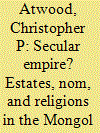

|
|
|
|
|
| Summary/Abstract |
Recent work in religious studies has emphasized how European colonial empires used the defining and constructing of religions and secularism as tools of rule. This article explores parallel processes in the Mongol empire (1206–1368) where ‘religion-making’ occurred in three areas: 1) a precise and legal definition of professional service estates among the conquered peoples that included the clergies of designated religions; 2) a broad and imprecise classification of nom or ‘way of life’ that partially overlapped with the clergies defined in the first category; and 3) a realm above all such sectarian distinctions destined for the Mongol ruling elite who alone were capable of living in free obedience to Heaven. The parallels and differences with classifications of the religious and the secular in European colonial empires shed light on how power interacts with cultural classification and practices.
|
|
|
|
|
|
|
|
|
|
|
|
|
|
|
|
| 9 |
ID:
184158
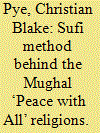

|
|
|
|
|
| Summary/Abstract |
The mystical method of taḥqīq (‘realization’ or ‘verification’ of divine truth), as promoted by the Andalusian thinker Ibn ‘Arabi (d. 1240), was central to the project of managing religious difference in the Mughal empire. The key architect of deploying taḥqīq for imperial purposes was emperor Akbar's senior minister, ideologue, and spiritual devotee, Abu al-Fazl. Specifically, I analyse how the concept of taḥqīq appears in Abu al-Fazl's 1587 preface to the Razmnāma (‘Book of War’), the first translation into Persian of the Sanskrit religious epic Mahābhārata. The Mughal Razmnāma was a monumental achievement, the foremost product of Akbar's push to translate non-Islamic religious works into Persian. In its elaborate preface, Abu al-Fazl clearly outlines that this translation was an exercise in taḥqīq, made possible by a sovereign who had achieved spiritual perfection, and he calls the Mughal empire a ‘Caliphate of Taḥqīq’. As such, this study bridges two scholarly conversations which have been previously distinct. One is the renewed focus in Islamic studies on Ibn ‘Arabi's ideas, specifically on taḥqīq in the late medieval and early modern periods across the Islamic world. The other is the recent interest in Mughal historiography on ṣulḥ-i kull (Total Peace). This article positions Ibn ‘Arabi's taḥqīq within an elite Persianate intellectual milieu that carried the concept to Mughal South Asia, and it demonstrates, through an analysis of the Razmnāma's preface, that taḥqīq was politicized by Abu al-Fazl and Akbar to develop the imperial policy of managing religious difference, which came to be known as ṣulḥ-i kull.
|
|
|
|
|
|
|
|
|
|
|
|
|
|
|
|
| 10 |
ID:
184151
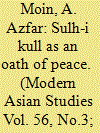

|
|
|
|
|
| Summary/Abstract |
Sulh-i kull or ‘Total Peace’ with all religions was a policy introduced by the Mughal empire in South Asia in the late sixteenth century. It was a radically accommodative stance for its day, especially when compared to the intolerant manner in which other Muslim and Christian polities of the early modern world dealt with religious difference. This article introduces a new perspective on Mughal Total Peace by arguing that it was meant to solve a long-standing problem created by the monotheistic ban on oaths sworn on non-biblical deities. Such a ban restricted the ability of Muslim kings to solemnize peace treaties with their non-monotheist rivals and subjects. In the second half of the article, I examine two pre-Mughal cases, from the eleventh century (Mahmud of Ghazna) and the seventh century (the prophet Muhammad), respectively, to explore what other, less ‘total’, mechanisms were invented to suspend this ban and enable oath-taking and solemn peace-making between monotheist and non-monotheist. In effect, I use the Mughal case to highlight a specific issue that shaped political theology in Islam over the long term.
|
|
|
|
|
|
|
|
|
|
|
|
|
|
|
|
| 11 |
ID:
184159


|
|
|
|
|
| Summary/Abstract |
Centred on the ‘devotion to the ineffable divine’ (nirguṇ bhakti), the sectarian community known as the Dādū Panth (lit. ‘Dādū's path) had a class of sant-intellectuals who conceived their tradition on high literary and philosophical grounds. Succeeding on the local level, but aspiring to imperial ties, the intellectuals of the Dādū Panth not only built their community identity in relation to the Mughal-Rajput imperial milieu but also to the overlapping ideals of emerging sulh-i kull (universal peace) and Vedānta paradigms. Such expertise on the part of the Dādū Panthīs made their ties with the Marwar royal polity strong and long-lasting, as demonstrated in their hagiographical accounts which are corroborated by land grants by the kingdom. Later in the eighteenth and nineteenth centuries, when the imperial order was waning, the Dādū Panthīs expanded their networks in the Rajput courts of not only Rajasthan, but also Gujarat and Madhya Pradesh. The sants of the bhakti movement(s) are normally thought to have had a lower-caste base—and thus a subaltern voice—but the example of the Dādū Panth presented in this article demonstrates that sants’ social base was broad and that the interrelation of sant-bhakti with the courtly order was strong; sant-bhakti therefore needs to be rethought in the study of bhakti traditions.
|
|
|
|
|
|
|
|
|
|
|
|
|
|
|
|
| 12 |
ID:
184152
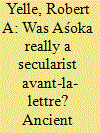

|
|
|
|
|
| Summary/Abstract |
Focusing on Rajeev Bhargava's claim that Aśoka was a secularist avant-la-lettre, I dispute the common understanding of secularism as the separation of religion and politics, and argue instead that such separation, to the extent that it existed, was characteristic of traditional religious societies. I then offer an alternative history of secularism as the demise of the traditional balance of power between church and state, and the rise of a unitary state which incorporated a civil religion that excluded competing forms of religiosity within its domain. This model of secularism, exemplified by the seventeenth-century English philosopher Thomas Hobbes, fits Aśoka's Dhamma better than the separationist model does.
|
|
|
|
|
|
|
|
|
|
|
|
|
|
|
|
| 13 |
ID:
184162
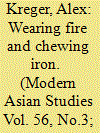

|
|
|
|
|
| Summary/Abstract |
This article examines the practices and discourses surrounding the ikrar oaths by which some Alevis in Turkey and the Turkish diaspora are initiated into their spiritual path. I examine a contemporary revival of this Alevi oath complex, which is a historical product of the same messianic trends in post-Mongol Sufism that shaped the Mughal imperial idea of sulh-i kull, or ‘Peace with All’ religions. I argue that the ikrar oaths are paradigmatic examples of ‘post-Islam’ or Islam after the messianic suspension of its scriptural law. I show how Alevis seek to maintain their suspension of monotheism through ritual practices of animal sacrifice and music as well as the replacement of standard monotheistic oaths with post-Islamic oaths. Focusing on a recent liturgical reform movement led by the shrine of Hacı Bektaş in central Turkey, I demonstrate how the shrine works to maintain Alevis’ suspension of monotheism within the constraints of modern secularism, in part by reinterpreting secular constraints in terms of post-Islamic Alevi values, thereby highlighting elective affinities between post-Islam and secularism.
|
|
|
|
|
|
|
|
|
|
|
|
|
|
|
|
|
|
|
|
|